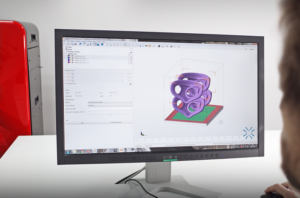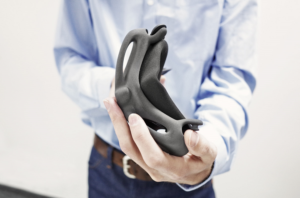Designer Uses Sinterit Lisa and Autodesk Netfabb to Design and 3D Print Children’s Protective Face Mask
 We see a lot of 3D printed masks here on 3DPrint.com, and while plenty are designed for fun events like Halloween parties and cosplay, many 3D printed masks serve very specific purposes in the medical field. One example we’ve seen is a 3D printed air-filtering face mask, an unfortunately necessary accessory in cities where the air quality is increasingly contaminated. However, while there are many styles of protective masks for adults, there are not nearly as many available for children, who require even more protection as air pollution is more harmful to them.
We see a lot of 3D printed masks here on 3DPrint.com, and while plenty are designed for fun events like Halloween parties and cosplay, many 3D printed masks serve very specific purposes in the medical field. One example we’ve seen is a 3D printed air-filtering face mask, an unfortunately necessary accessory in cities where the air quality is increasingly contaminated. However, while there are many styles of protective masks for adults, there are not nearly as many available for children, who require even more protection as air pollution is more harmful to them.
3D designer Bartlomiej Gaczorek wanted to offer a solution for this problem, and designed a 3D printed anti-pollution children’s face mask from scratch. The job was tough, and couldn’t be accomplished by simply scaling an existing mask down to a smaller size, so he worked with desktop SLS 3D printer manufacturer Sinterit, using its Lisa 3D printer and Autodesk Netfabb 3D printing software to create a low-weight mask.
Netfabb can streamline a project workflow to move quickly from a preliminary 3D model to 3D printed parts, speeding up the printing process and allowing for interference in the structures of 3D printed solids, which means parts can maintain strength while being more lightweight.
 The desktop SLS Lisa can manufacture both flexible and durable components, so rigid parts of the mask and its anatomically adjustable face section could both be printed on the same machine; it can also 3D print “permanent, targeted elements that could be treated and painted to create a final product,” according to a release.
The desktop SLS Lisa can manufacture both flexible and durable components, so rigid parts of the mask and its anatomically adjustable face section could both be printed on the same machine; it can also 3D print “permanent, targeted elements that could be treated and painted to create a final product,” according to a release.
In designing the neo-futuristic “brifo” dust mask, Gaczorek needed to make the product appealing to children; a colorful finish and a front part that resembles a superhero’s mask accomplishes this. The mask was created to provide respiratory protection during creative activities like gluing and painting, as well as in areas of high air pollution, and it was important to protect the mask’s filters without making it heavier.
Gaczorek chose Netfabb to design the mask thanks to its ability to create internal lattices, which allowed him to beef up the structure into something more organic, while keeping the design slim and lightweight without reducing durability or functionality. While nearly all complex projects have issues that come up during the design process, Autodesk Netfabb can detect and analyze problems and repair meshes, which reduces the printing time.
“My common workflow, from idea to prototype, comes through CAD design, exporting, hollowing, infilling, and nesting inside the printer’s build volume. Until now I had to use different software for almost every operation. Repeated imports and exports are not only frustrating, but could corrupt the final output file,” said Gaczorek.
“Thanks to Autodesk Netfabb Ultimate, I export only once from my CAD software and do all the preparation there. And this is a true industry standard 3D printing tool with many automated scripts and a huge number of state-of-the-art machines. One of them is Sinterit Lisa, a desktop SLS printer. SLS is a technology of 3D printing with almost no restrictions in the shaping of parts, perfect for organic and complex geometries and even interlocking elements.”
 The designer chose the Sinterit Lisa from a provided list of 3D printers within Autodesk Netfabb, and from the very beginning was able to see the available workspace for the project. The software, which also offers live collision detection, maximizes the print bed by using an automatic packing feature.
The designer chose the Sinterit Lisa from a provided list of 3D printers within Autodesk Netfabb, and from the very beginning was able to see the available workspace for the project. The software, which also offers live collision detection, maximizes the print bed by using an automatic packing feature.
“The most interesting thing about the Netfabb Ultimate is inside. The repairing, hollowing, and lattice infilling algorithms are simply amazing. Where other software fails, the Netfabb Ultimate does the job effortlessly,” Gaczorek said. “A solid piece can be hollowed and filled with crystal-like lattice structures and vents for removing unsintered powder can be added in few simple steps. This reduces the final weight and material consumption by 50 percent as compared to a solid part. It seems Netfabb Ultimate is a perfect match for an SLS printer like Sinterit Lisa.”
At the end of the design process, the completed file was saved in an extension supported by the Sinterit Lisa, so printing could begin immediately without the use of additional 3D software – a useful feature for designers who want to get the job done fast…and correctly.
Discuss this and other 3D printing topics at 3DPrintBoard.com or share your thoughts below.
[Images provided by Sinterit and Autodesk Netfabb]
Subscribe to Our Email Newsletter
Stay up-to-date on all the latest news from the 3D printing industry and receive information and offers from third party vendors.
You May Also Like
3D Printing Financials: Fathom Struggles in Financial Quicksand During Critical Transition
Facing a year of key transitions and financial pressures, Fathom (Nasdaq: FTHM) has filed its annual report for 2023 with the U.S. Securities and Exchange Commission (SEC). The document outlines...
Latest Earnings Overview for Australian 3D Printing Firms Titomic and AML3D
Australian 3D printing manufacturing firms Titomic (ASX: TTT) and AML3D (ASX: AL3) reported their financial results for the period from July to December 2023, marking the first half of their...
3D Printing Webinar and Event Roundup: April 7, 2024
Webinars and events in the 3D printing industry are picking back up this week! Sea-Air-Space is coming to Maryland, and SAE International is sponsoring a 3D Systems webinar about 3D...
3D Printing Financials: Unpacking Farsoon and BLT’s 2023 Performance
In the Chinese 3D printing industry, two companies, Farsoon (SHA: 688433) and Bright Laser Technologies, or BLT (SHA: 688333), have recently unveiled their full-year earnings for 2023. Farsoon reported increases...





































